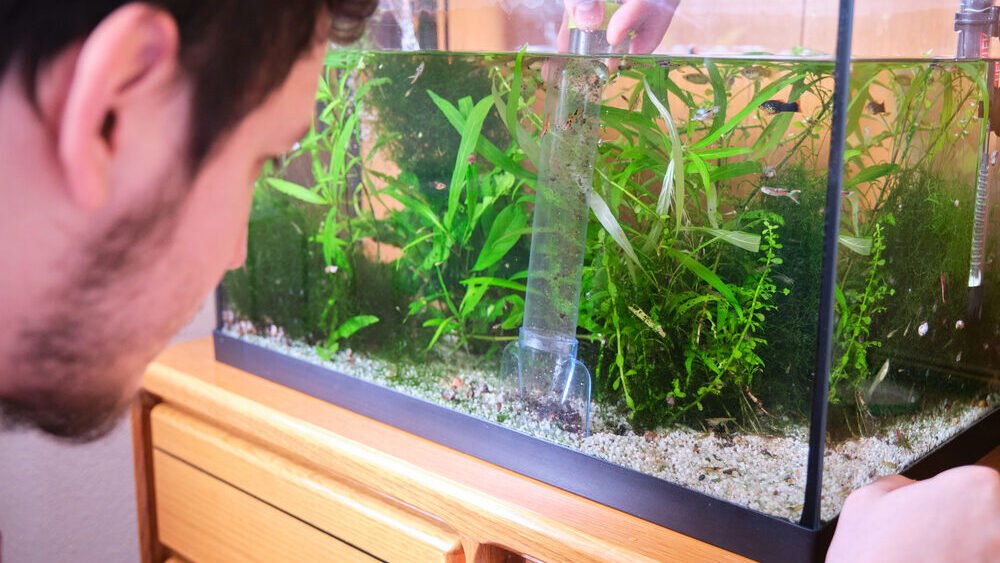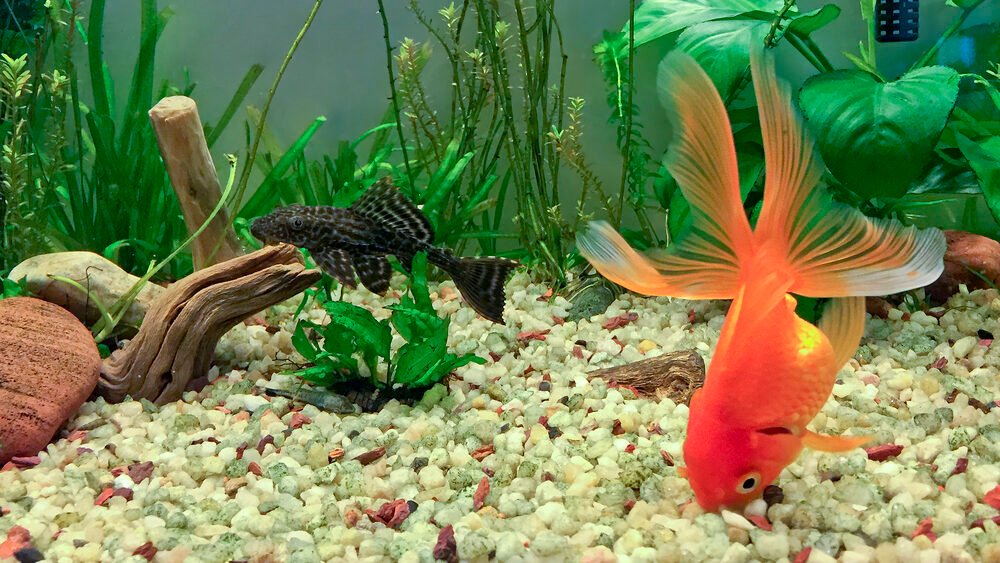Why Does My Fish Lay at the Bottom of the Tank? Causes & Solutions
Do you ever notice your fish hanging out at the bottom of the tank? It could be chillaxing. But it’s not moving or swimming around like it usually would. Should you be worried?
Let’s unravel the big mysteries about “why is my fish at the bottom of the tank” once and for all.
Potential Causes for why your fish is on the bottom of the tank

Fish may stay near the bottom because they prefer the tank floor and could be bottom feeders or bottom dwellers. It depends on the type of fish you have—for example, betta fish like shallow water.
Age
Older fish are naturally less active than younger fish because of their age and reclining energy levels, so it’s not unnatural for them to prefer staying at the bottom of their tank instead of swimming around all day.
Illness
The most common reason for nearly-dead fish is an illness. When your fish has a disease (such as swim bladder infection), it can get depressed and just lay at the bottom with some of the following symptoms (look for these signs as they could be an indication that your fish is sick):
- Clamped fins
- White spots or patches on the skin
- Loss of appetite
- Gasping at the surface
- Cloudy eyes
If there are several fish in one tank, one option is to put the one fish that looks sick in a quarantine tank until it gets better if you worry about infectious diseases that can spread to other fish. But if you see anyone or more of these symptoms, you should consult a veterinarian to diagnose and treat the fish.
Water Quality Issues
A big reason for depressed fish is terrible water quality; if the water parameters are wrong, that can also cause illness.
Make sure to check the conditions of the fish tank to cross this cause off the list. It would be best if you looked out for these things:
- pH levels that are too high or too low
- Ammonia and nitrite levels that are too high
- Chlorine or chloramines in the water
- Low oxygen levels
- Low or high water temperature
- Dirty water with a lot of waste.
If you believe you have problems with the water quality, you can use a test kit to check the different readings and a thermometer to check the temperature. If the water is the problem, there are many ways to start fixing it, depending on what is worsening the water conditions. You can install a filter, or air bubbler, do more frequent water changes, adjust the temperature, and so on.
Stress
Fish are easily stressed animals. If you move one fish to another tank, you should acclimate it slowly and gradually to avoid distress. Much wild fish caught and put in captivity don’t survive the acclimation processes because of stress. In other words, fish are highly susceptible to stress.
Many reasons can cause a fish to become stressed:
- Unnatural habitat or environment
- Overcrowding in the tank or fish swimming too close
- Aggressive or territorial tank mates
- Low oxygen
- Inadequate food
- Poor water quality
- Disease
- Trouble acclimating to the tank
- Introducing new fish to the tank
If you can identify the cause of stress, you should do what you can to prevent it, as healthy fish is a stress-free fish, and a stressed fish isn’t healthy.
Other Possible Causes of Why Fish Stay on the Bottom of the Tank
Here are a few other potential causes:
- Overcrowding
- Lack of oxygen
- Inadequate food
- Depression
Consider if any of these applies to your aquarium and fish.
Prevention and Solutions

Let’s look at things you can do to reduce the risk or prevent you from experiencing your beloved pet fish looking depressed on the fish tank floor.
Regular Water Testing and Maintenance
The one thing to put on your calendar with a notification is to check the water quality frequently, especially if you have experienced these problems. You should test the water conditions at least every three months, but many fish experts recommend monthly testing.
You can buy test kits from a pet store with aquarium supplies and check for pH levels, ammonia, nitrite, chlorine, and chloramine levels. Also, check the oxygen level, filtration system, and temperature.
Proper Tank Size and Stocking Levels
Depending on how many fish you have in the community tank, you may have to buy a bigger tank or keep fewer fish in it. An overcrowded fish tank with too many fish can cause stress. Imagine being locked in a tiny glass prison cell with a bunch of strangers, and you don’t even have a corner to yourself: no privacy or alone time. It can’t be fun.
Providing a Suitable Environment
One of the most critical factors in keeping your fish happy is providing the proper habitat and environment with the correct substrate, lighting conditions, water depth, plants, temperature, decorations, and suitable friends. You want to try to recreate the natural habitat and not be an artificial glass bowl with nothing interesting.
Proper Nutrition
Like humans, fish also need nutritious food to live a healthy life. Some fish are carnivores, and others are omnivores, and you should buy species-specific food sources of high quality to ensure it gets a balanced diet. You can find these foods at the pet store, which come as flakes or pellets. The amount and frequency you feed them also matter, so read the instructions carefully. If you provide your fish too often or too much, it can lead to obesity and disease, and uneaten food can turn into waste and dirty the tank water.
Monitoring Fish Behavior
We all live busy lives and imagine our fish tank taking care of itself while we are sleeping or at work. But we should all keep an eye on our fish when we have the time. Check on the fish before leaving for work, when returning in the afternoon, and before going to bed at night. If you monitor the fish’s behavior, you are more likely to notice when anything isn’t as it’s supposed to be. You can quickly detect disease symptoms or strange behavior, such as passively hanging out at the bottom of the tank and not swimming around.
Solve the Problem
Once you identify a cause, you should do what you can to fix the problem. If your fish is sick, consult a veterinarian to diagnose and treat it or prescribe fish medication. If the water conditions are bad, fix it. If the fish is stressed, change its environment to a calmer one.
Conclusion

There are several reasons that a fish stays passive on the aquarium floor. Once you understand the cause, you can take action to solve it. If you do your best to keep your fish healthy and happy, your fish will love you in return.
Frequently Asked Questions
Why is my fish at the bottom of the tank?
A few reasons could be illness or disease, water quality issues, stress, or other causes.
What are the symptoms of a sick fish?

Symptoms of a sick fish include:
Clamped fins.
White spots or patches on the skin.
Loss of appetite.
Gasping at the surface.
Cloudy eyes.
How can I improve the water quality in my fish tank?

Regular water testing and maintenance, proper tank size and stocking levels, and providing a suitable environment can help improve water quality in your fish tank.
What causes stress in fish?
Overcrowding, lack of oxygen, inadequate food, and poor water quality are potential stress causes.
How can I make sure my fish are getting proper nutrition?
Provide a balanced diet with the right kind and amount of food, and monitor the fish’s behavior.
What should I do if my fish is not eating and lying at the bottom of the tank?

Not eating could indicate depression or illness, so consult a professional veterinarian immediately.
How can I prevent my fish from staying at the bottom of the tank?
By regularly testing and maintaining the water quality, providing a suitable environment, proper tank size and stocking levels, proper nutrition, and monitoring fish behavior, you can prevent your fish from staying at the bottom of the tank. Additionally, seeking professional help if you suspect illness or disease, and addressing any stress-inducing factors, can also help prevent this behavior.

